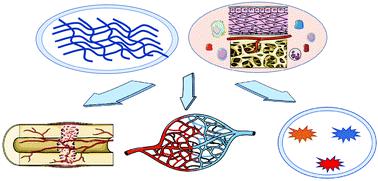当前位置:
X-MOL 学术
›
J. Mater. Chem. B
›
论文详情
Our official English website, www.x-mol.net, welcomes your feedback! (Note: you will need to create a separate account there.)
The antigenicity of silk-based biomaterials: sources, influential factors and applications
Journal of Materials Chemistry B ( IF 7 ) Pub Date : 2021-08-26 , DOI: 10.1039/d1tb00752a Yanlin Long 1, 2, 3 , Xian Cheng 4 , Qingming Tang 1, 2, 3 , Lili Chen 1, 2, 3
Journal of Materials Chemistry B ( IF 7 ) Pub Date : 2021-08-26 , DOI: 10.1039/d1tb00752a Yanlin Long 1, 2, 3 , Xian Cheng 4 , Qingming Tang 1, 2, 3 , Lili Chen 1, 2, 3
Affiliation

|
Silk is an ancient material with essential roles in numerous biomedical applications, such as tissue regeneration and drug delivery, because of its excellent tunable mechanical properties and diverse physical structures. In addition to the necessary functionalities for biomedical applications, another critical factor for materials applied in biology is the appropriate immune interactions with the body. This review focuses on the immune responses of silk-based materials applied in biomedical applications, specifically antigenicity. The factors affecting the antigenicity of silk-based materials are complicated and are related to the composition and structural characteristics of the materials. At the same time, the composition of silk-based materials varies with its species sources, such as silkworms, spiders, honey bees, or engineered recombinant silk. Additionally, different processing methods are used to fabricate different material formats, such as films, hydrogels, scaffolds, particles, and fibers, resulting in different structural characteristics. Furthermore, the resulting body reactions are also different with different degrees of the immune response. Silk protein typically induces a mild immune response, and immunogenicity can play active roles in osteogenesis, angiogenesis, and protection from inflammation. However, there are some rare reports of severe immune responses caused by silk, which can result in an allergic response or tissue necrosis. The source of allergenicity in silk-based materials is currently under-studied and how to regulate and eliminate the overreaction of the immune system is essential for further applications. Overall, the diverse characteristics of silk-based materials mostly show beneficial bioresponses with mild immunogenicity, and the tunable properties make it applicable in immune-related biomedical applications.
中文翻译:

丝基生物材料的抗原性:来源、影响因素及应用
丝绸是一种古老的材料,在许多生物医学应用中具有重要作用,例如组织再生和药物输送,因为它具有出色的可调节机械性能和多样的物理结构。除了生物医学应用的必要功能外,生物应用材料的另一个关键因素是与身体的适当免疫相互作用。这篇综述的重点是生物医学应用中应用的丝基材料的免疫反应,特别是抗原性。影响丝基材料抗原性的因素较为复杂,与材料的组成和结构特点有关。同时,丝基材料的组成因物种来源而异,如蚕、蜘蛛、蜜蜂、或工程重组丝。此外,不同的加工方法用于制造不同的材料形式,如薄膜、水凝胶、支架、颗粒和纤维,导致不同的结构特性。此外,所产生的身体反应也随着免疫反应程度的不同而不同。丝蛋白通常诱导温和的免疫反应,免疫原性可以在成骨、血管生成和炎症保护中发挥积极作用。然而,有一些罕见的关于丝绸引起的严重免疫反应的报道,这可能导致过敏反应或组织坏死。丝基材料的致敏性来源目前研究不足,如何调节和消除免疫系统的过度反应对于进一步应用至关重要。全面的,
更新日期:2021-09-20
中文翻译:

丝基生物材料的抗原性:来源、影响因素及应用
丝绸是一种古老的材料,在许多生物医学应用中具有重要作用,例如组织再生和药物输送,因为它具有出色的可调节机械性能和多样的物理结构。除了生物医学应用的必要功能外,生物应用材料的另一个关键因素是与身体的适当免疫相互作用。这篇综述的重点是生物医学应用中应用的丝基材料的免疫反应,特别是抗原性。影响丝基材料抗原性的因素较为复杂,与材料的组成和结构特点有关。同时,丝基材料的组成因物种来源而异,如蚕、蜘蛛、蜜蜂、或工程重组丝。此外,不同的加工方法用于制造不同的材料形式,如薄膜、水凝胶、支架、颗粒和纤维,导致不同的结构特性。此外,所产生的身体反应也随着免疫反应程度的不同而不同。丝蛋白通常诱导温和的免疫反应,免疫原性可以在成骨、血管生成和炎症保护中发挥积极作用。然而,有一些罕见的关于丝绸引起的严重免疫反应的报道,这可能导致过敏反应或组织坏死。丝基材料的致敏性来源目前研究不足,如何调节和消除免疫系统的过度反应对于进一步应用至关重要。全面的,



























 京公网安备 11010802027423号
京公网安备 11010802027423号